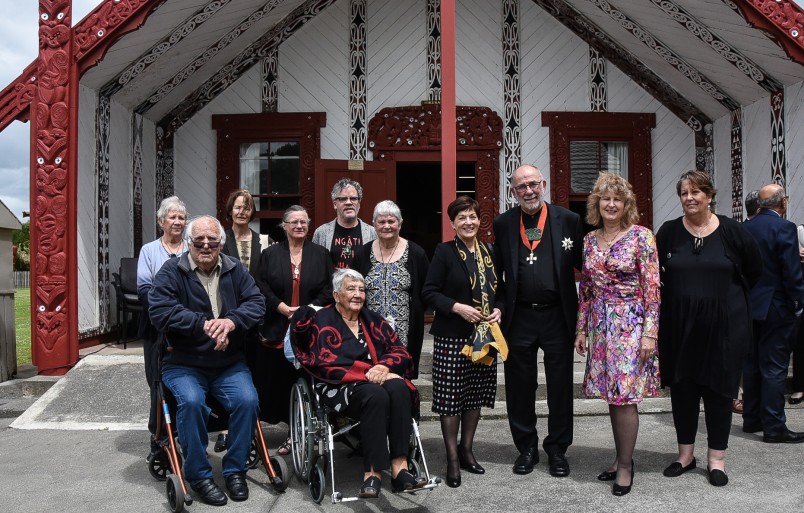Papawai Marae Wananga

E nga iwi o Te Wairarapa tena koutou katoa. Tena koutou i Te Kotahitanga me tona kaupapa atawhai tona kaupapa paihere i nga iwi o Aotearoa. Otira, tena tatau katoa.
Thank you so much for inviting me here today.
It’s a privilege to be part of this gathering at Pāpāwai, and I’m delighted that a wananga was deemed an appropriate way to honour Sir Kim Workman’s dedication to criminal justice reform, culminating in his well-deserved knighthood, which I was delighted to confer on him earlier this year.
Sir Kim has, on occasion, spoken of the need to create spaces to listen to communities of others, and also advocated for a collective vision for race relations in Aotearoa/New Zealand.
Pāpāwai Marae is one such space where those discussions can be advanced.
Today’s wananga represents continuity with Pāpāwai’s distinguished heritage as a place of dialogue and pride in cultural identity.
It recalls Pāpāwai’s tradition as a place where people could congregate to find workable solutions to the pressing issues of the day.
Today’s korero echoes the questions of nationhood, identity, and the rebalancing of history, which underpinned debates here in the 1890s, when Māori sought ways to respond to government policy and advance Māori wellbeing.
We are very much walking in their footsteps.
I think of one of my predecessors as Governor-General, Lord Ranfurly, and the Premier, Richard Seddon, visiting the Aotea/Waipounamu complex here at Pāpāwai in 1897.
No doubt Sir Kim and other tangata whenua here will be thinking of their tipuna, whether they were strong supporters of kotahitanga, or fiercely resistant to the transfer of the Wairarapa Lakes to the Crown.
This year, there’s a new momentum to rebalance and reclaim our history. More New Zealanders than ever want to know about our pre-European history and the New Zealand Wars.
The Tuia 250 commemorations have been part of this momentum.
Iwi are celebrating and reviving cultural connections with extended whanau in the Pacific. They are recalling the experiences of their tipuna, before and after the arrival of Tasman, Cook, and de Surville.
Tuia has also become a catalyst for strategic conversations about Crown/iwi relations in the post-settlement era, echoing the discussions which were held here in the 1890s about how Māori could work with the Crown.
During my time as a Chief Crown Negotiator on Treaty Settlements, I developed a keen interest in the pre-European and colonial history of Aotearoa New Zealand, and an awareness that we all live with that history to this day. I firmly believe that it is important that the history of this place is shared and understood by all who live here.
Pāpāwai’s recognition as the first marae to be listed as a waahi tupuna on the New Zealand Heritage List comes at an opportune time, coinciding with the new commitment to include New Zealand history in our school curriculum.
It will enable every school-child to learn about Pāpāwai and the role it played in our history.
For the children of this region, the history will include learning about the pattern of settlement, beginning with the very ancient settlements on the south coast.
They will learn how Ngati Kahungunu, Ngati Rangitane and Ngai Tahu lived and thrived in this environment, adapting to the regular flooding of the wetlands and land around the lakes.
It will include the arrival of Europeans centuries later, in search of grazing for the sheep and cattle that accompanied them on their long walk around the rocky coastline from Wellington.
It will spark greater awareness of the subsequent disruption of the cultural, economic, spiritual and physical wellbeing of Wairarapa iwi, and their disastrous relocation to the Pouakani Block in the King Country, which was pumice land and incapable of development at the time.
And the history will acknowledge the remarkable community that flourished here at Pāpāwai, with its own newspaper, Te Puke ki Hikurangi – and the hosting of two sessions of the Māori Parliament.
By the 2040s, 200 years after those first Europeans arrived, when new generations of New Zealanders will be better connected with our history and more fluent in te Reo Māori, I believe parallel institutions that serve Māori wellbeing – for which Sir Kim has long advocated – will be the norm.
I am a relative newcomer to South Wairarapa, and a part-timer at that - David and I first acquired land and built a home in the district, overlooking Lake Onoke, around 15 years ago and more recently we moved to Greytown.
I now feel like the Wairarapa is my turangawaewae and I look forward to coming back to Pāpāwai and learning more about the people and this place.
I did wonder if Tamahau Māhupuku’s beloved Hikurangi brass band might have been revived for today’s hui – perhaps next time. I am sure he and his band are with us in spirit.
I hope that today’s wananga, encircled by tekoteko of tipuna – representing iwi and a European settler – will draw inspiration from their message of peace and dialogue, while honouring the vigorous exchange of views which characterised debate in the Māori Parliament – and that this will be just the start of many similar hui and wananga in Pāpāwai in the years to come.
In the words of your tipuna, Tamahau Māhupuku
Ka pu te ruha, ka hao te rangatahi.
Kia ora tātou katoa.
